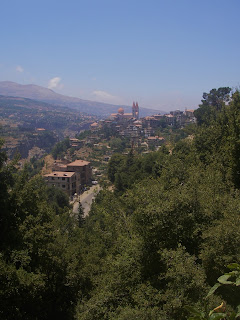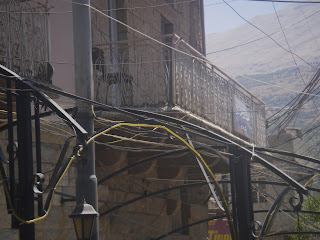
When I was in Lebanon this summer, every few days I would nag my husband, “I’m not leaving Lebanon this time without going to the Gibran House and Museum.” So it happened that one day came the day that finally my husband, his brother, Sabah, his wife, Cheryl, and I took a road trip to Bcharre (also spelled Bsharri), a village in the northern mountains, to visit the house where Khalil Gibran was born and to see the Gibran Museum and Tomb, which is built into a cave in the side of a mountain.
If you are queasy with heights, I recommend you take the northern highway that speeds directly straight to Ehden rather than the old scenic road that snakes its way up along the southern ridge of the Kadisha Valley, the long and winding road that cuts through numerous villages, including Hasroun, the ancestral village of Walter Assef, former mayor of Thunder Bay, whose father was born there.
Hasroun. image source from Landscapes of Lebanon: Illustrating Twenty Poems for One Love by Nadia Tueni(1935-1983), an outstanding award-winning Lebanese poet and writer.
Hasroun is forever immortalized in all of our minds (my brother-in-law and his wife once lived in Thunder Bay and our young children played together); as we drive through this picturesque village we all chant: “here’s where Walter Assef is from!”
There is no denying that you are in conservative Maronite Christian Patriarch territory. Cemeteries, shrines, churches, posters large and small and other signs of a patriarchal Maronite history and presence abound. Sabah pointed out the cemetery on the edge of the gorge that him and his friends slept in one night to escape getting beaten up by angry villagers chasing them because of a teenage prank they pulled.
"Dear god!" I said. "Sleeping in a graveyard? And this one, perched so precariously on the edge of the gorge? What if a fierce supernatural being swooped down from the sky and tossed you down the ridge? Or a ghost emerged from a crypt?"
No, he laughed. We knew we would be safe in there at night. No one would look for us in there.
He also pointed out the old cinema in the center of the village where he first saw Romeo and Juliet, the 1968 Franco Zeferelli film that inspired and shaped the minds of so many young people, here, there, and everywhere popular culture descended like a new religion. As my brother-in-law skilfully and speedily manoeuvred the car along the edge of the cliff, I told my sister-in-law that after seeing Romeo and Juliet, I sewed a brown velveteen Juliet-sleeved, high collared-lace trimmed, empire waisted velvet ribboned dress for the Gr. 8 Christmas dance at Algonquin Public School. Such were the dreams of budding young romantics in whose minds flower power and Shakespeare blossomed side by side.
The old road was made long before cars were invented; its many hairpin turns, many without guardrails, may make you uncomfortable. I know you will never find my mother on that road. Then again, you may find the rapid ascent into the mountains exhilarating and refreshing, especially in contrast to the heat, humidity, and congestion of Tripoli and Beirut. The beauty of Lebanon is that it is a country of contradictions that live side by side with the unexpected always presenting itself around the next corner.
Bscharre. The etymology of its name is Phonecian/Canaanite, meaning "The House of Ishtar."
It's not easy to describe Bscharre; it's a small village of awesome magnificence. Gibran, of course, spent an entire lifetime immortalizing this House of Ishtar in his writings, paintings, sketches and poetry, and he is the best source.
Other writers have given a glimpse; from "In Gibran's City" by Maroun Abboud, c. 1954 :
"Bsharri sleeps in the lap of the mountain, the brooks sing for her and the breeze lulls her; the Qadisha river passes under her feet, and she is, thus, always in a cold bath. In her stand erect the poplars like giants amongst the dwarf fruit trees. Were it not for the houses, you would think her a fertile oasis; and were it not for the bells constantly tolling for prayer, especially the Carmelite priests bell, you would deem yourself in seclusion. No shouting or screaming in Bsharri; you pass by her coffee shops as if passing through a reading room, even though you might not see a book nor a newspaper.
The mountains surround her from four sides, and wherever you turn you see peaks erect like statues and domes; from the East dangles the waterfall, a silver chain in the neck of the beautiful "Jubbah"; and you see the electricity pipes of Qadisha like the snake that deceived our mother Eve -- that is if it were black, since every theologian dresses it with a color of his own imagination -- but the water is always snow-cold, and is a delicious seasickness to what the kitchens build."
The house where Gibran was born is a simple peasant-style one-room stone house at the top of the village square. Like other old-style homes, it does not need AC to stay cool as do the new villas and buildings that are rapidly mushrooming across the Lebanese landscape. Its simple charm is a step back in time with old cooking pots, a small fireplace, a rocking chair, two wooden chests, one long one with a padded wool batting top that appears to also have been a bed, a white wrought iron single bed, and striped sofa cushions, woolen and worn, that sit on the earthen ground, edging the walls and wrapping around a large copper tray table.
I realized later as I tried to scrub clay coloured stains off my white cropped jeans that wearing white that day wasn’t a smart choice, after all. Dropping my bag to the earthen floor to take photos it seems I had inadvertently brushed the dusty earth of Bscharre all over the legs of my pants.
On the way out, Charlotte, the well-informed tour guide who brought us through the house, pointed to a window and told me to take a photo looking out onto the memorial statue of Gibran. As we were leaving the Gibran House, a group of tourists in a van pulled up and spilled out onto the steps, with Charlotte leading the way to the house.
I didn’t realize until later that it was the same window that caught my eye on the way in to the house.
Before we had gone into the Gibran House, we had stopped in the town square just below it to eat breakfast, freshly baked zaatar pies (made with local savory herb and sesame seeds) and cheese pies (local cheese) at a small shop along the long stairs that run up the slope. Enjoying my pie and beer, I watched two young boys walking up the stairs; one had a toy submachine gun in his hands. Awhile later, I noticed two other young boys walk up the stairs; one had a PSP in his hands.
Returning my empty beer bottle back to the zaatar shop after we left the Gibran House, I looked up and noticed a tangled mass of electrical wires surging overhead.
"Those would not have been there when Gibran lived here" I said to my sister-in-law as we walked down the stairs to the large stone spring-fed water fountain in front of the main church at the bottom of the square. After sipping ice cold water, we climbed back in the car and headed for the Gibran Museum and Tomb.
The Gibran Museum and Tomb are in Mar Sarkis, a former Christian Carmelite monastery that Gibran had wished to buy. The Museum and Tomb are a short car ride up the road from the center square of the village, but in the old days would have been a pilgrimage up the mountain towards solitude. It is sometimes a challenge to remove one's car culture eyes and imagine life before the paved roads we zip along on. Perhaps in days gone by, the trip from Bishmezzine to Bscharre was a week long affair of numerous stops along the way, rather than scheduled into a day where one had to get back before 2:30 to have dinner with mother-in-law.
I guess someone thought Gibran needed a drink.
The museum has a room that replicates Gibran's living space, and it holds some of his personal items that would have been in his studio (which was in New York; he called it the Hermitage). The museum holds a large selection of Gibran’s paintings and drawings (his visual art numbers about 400, but some are in museums in the US and others in private collections). The paintings and drawings in the museum are quite remarkable viewed as a collection in the silence inside the mountain. The paintings are exhibited in groupings in cave-like rooms, the later rooms going deeper into the mountain and higher, so that one needs to climb a steep set of stairs. It is not wheelchair accessible. No photos are allowed.
To reach Gibran’s tomb, after going up the stairs to the last gallery, you then go down a narrow flight of stairs into a cave where the walls are covered in a deep emerald green moss. The air is heavy and damp, but pleasant. It is quiet. You could hear a church mouse enter. His coffin is in a deep recess in the cave wall with a twisted old cedar trunk placed before the opening, so his grave is screened by a natural cedar sculpture.
After we left, we stopped to browse through the books that were for sale, but like many tourist sites, they were over-priced. I picked up a copy of Gibran Love Letters later, at Antoine’s on Hamra Street in Beirut, where it was 12 US dollars cheaper. In this edited and translated collection of Gibran’s letters to May Ziadah, a renowned Palestinian writer who had lived in Lebanon and had a literary salon in Egypt in the 1920s, Gibran tells her in a letter dated Dec. 3rd 1923:
“What can I say in response to your remarks about The Prophet? What should I say to you? This book is only a small part of what I have seen and of what I see every day, a small part only of the many things yearning for expression in the silent hearts of men and in their souls. There has never been anyone on the face of this earth with the ability to achieve anything by himself, as an individual completely cut off from all other human company. Nor is there anyone among us today who is able to do more than record what people say inadvertently. The Prophet, May, is only the first letter of a single word.”













5 comments:
What a wonderful trip. What great beauty. I admired your breakfast. What time of day was it?
Hello 29th C Woman,
Our breakfast was about 10:30 - 11 a.m. The fun thing about going anywhere in Lebanon is that it always involves stopping somewhere to eat. And the places to stop are numerous and every place, no matter how small or elaborate, has delicious food. Lebanon is a place where ambiance hangs heavy in the air wherever you go.
I read your travel journal about Lebanon with so much delight; it is wonderful to see it through the eyes of a benevolent outsider; yet you have more insight than most on the country and culture! I visited Besharré a few years back but it was too crowded. I need to go back.
hello taste of b,
I did not spend too much time in Beirut this visit as it was too hot and sticky! I'm going to visit your blog and search a stuffed eggplant recipe. I've emptied out some tiny eggplants and need to cook them up!
wonderful pictures , can you please post them on www.lebanon-pictures.com
Post a Comment